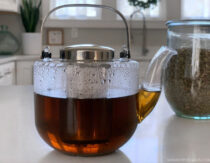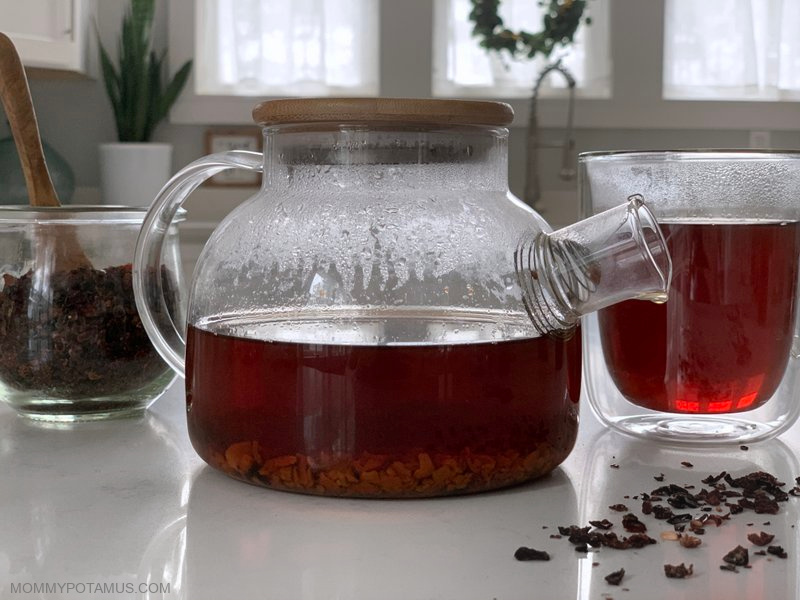
Quick, when I say “roses” what’s the first word that comes to mind for you? Is it Vikings? No? Well, let me tell you a story.
According to Nordic folklore, Viking raids were fueled by the fruit of the rose plant, which is loaded with vitamin C and other compounds that support immunity, vitality and well-being.
Excavation of Viking sites confirms that they did use herbs including rosehips and meadowsweet as both food and medicine, and for good reason. Aspirin was first derived from meadowsweet and willow bark, and rosehips have been used therapeutically since at least the first century in Rome. (1) (2) (3)
So what are the benefits of rosehips, and how can they be used to make tea, jam, syrup and more? We’ll cover all that below, but first I want to mention that none of these statements have been evaluated by the FDA, this article is not medical advice, and it is not meant to diagnose or treat any condition. Please talk with your healthcare provider about any herbal remedy or supplement you are considering.
Now that we’ve got that out of the way, let’s dive in!
- What are rosehips?
- Therapeutic Compounds In Rosehips
- Health Benefits of Rosehips
- 1. Counteracts Free Radicals
- 2. Supports Skin Elasticity & Collagen Production
- 3. Cardiovascular Health
- 4. Immune Function
- 5. May Ease Discomfort
- 6. Gut Microbiome Diversity
- 7. Digestive Issues
- More Benefits
- How To Use Rosehips
- Rosehip Tea Recipe
- Do rosehips have any side effects?
- Recommended Teapots
- Rosehips Tea Recipe
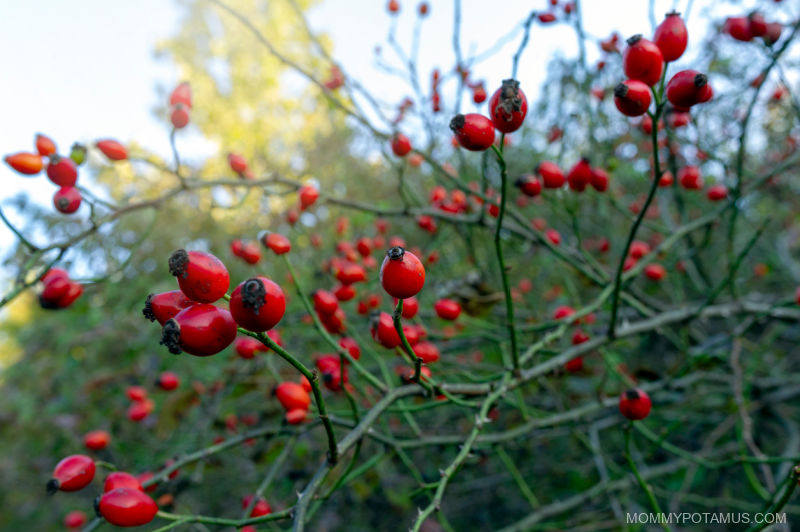
What are rosehips? ^
Aside from the thorns, pretty much every part of the rose plant is used therapeutically – petals, inner bark, leaves and of course the fruit (hips), which have a mild, tart flavor similar to crab apple.
There are literally hundreds of species of rose plants, but the first to be mentioned for its therapeutic benefits is the dog rose (Rosa Canina). It gets its name from Pliny the Elder, who noted that it was used by Gallic tribes to support recovery from dog bites.
Roses that are cultivated for their beauty tend to contain lower concentrations of therapeutic compounds, while roses that are cultivated for their fragrance tend to have higher concentrations.
The two main rosehip varieties that are used therapeutically today are Rosa canina (known as Common Rose, Dog Rose, Briar Rose, Hip Tree) and Rosa rugosa (Japanese Rose). Most of the available studies focus on them, but there is also research showing that Rosa gallica (Apothecary Rose) is beneficial as well. (4) (5) (6) (7)
Also known as hip fruit, rosehips grow in late summer/fall and range in color from red/orange to deep purple/black. They can be eaten cooked or raw, and used to make jam, tea, soup, wine, and even mead (a traditional Viking preparation).
Therapeutic Compounds In Rosehips ^
Rose hips are an excellent source of vitamin C and the entire vitamin C complex – in fact, they contain up to sixty times the vitamin C of citrus fruit, along with bioflavonoids that aid in the absorption of vitamin C. ” – Adaptogens in Medical Herbalism (8)
Though most famous for their high concentrations of vitamin C, rosehips are also rich in a variety of therapeutic compounds including:
- Polyphenols such as flavonoids
- Carotenoids such as astaxanthin and lycopene
- Ellagic acid
- Pectin
Fresh rosehips are higher in vitamin C content than cooked or dried rosehips, but the dried and cooked versions have their own gifts. For example, while heating rosehips to make tea or syrup will decrease the vitamin C content, it makes the lycopene found in rosehips more bioavailable.
Dried rosehips are more concentrated than fresh and have demonstrated therapeutic benefits in many studies, as we’ll discuss below.
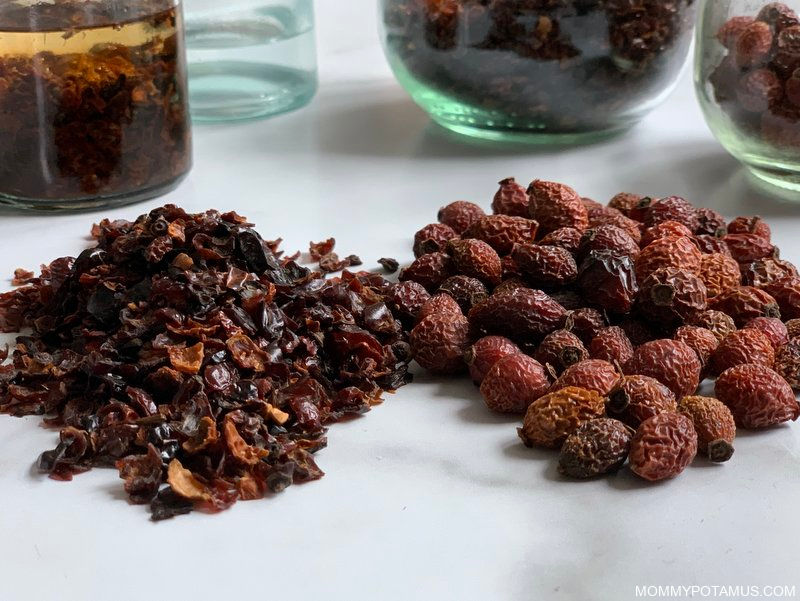
Health Benefits of Rosehips ^
Rose hips were used both cooked and raw, as food and medicine, before the word vitamin was coined.” Edible and Medicinal Plants (9)
Thanks to their high vitamin C content, “rosehips were used in Great Britain during World War II to prevent scurvy when there was a shortage of citrus fruit.” (8)
Rosehips are useful for more than just meeting minimum nutritional needs, though. Here are some of their top benefits.
1. Counteracts Free Radicals ^
We know that excessive amounts of free radicals – which our bodies produce as byproducts of metabolism – cause oxidative stress that can lead to accelerated aging and several disease processes.
Fortunately, as this Live Science article puts it,
Antioxidants are able to give an electron to a free radical without becoming destabilized themselves, thus stopping the free radical chain reaction. ‘Antioxidants are natural substances whose job is to clean up free radicals. Just like fiber cleans up waste products in the intestines, antioxidants clean up the free radical waste in the cells”
According to Donald R. Yance, CN MH RH(AHG), author of Adaptogens in Medical Herbalism, “Rose hips provide excellent antioxidant and free-radical scavenging effects, mainly due to their polyphenolic compounds, although the carotenoids and vitamin C also possess anti-oxidative effects.”
2. Supports Skin Elasticity & Collagen Production ^
Collagen makes up about 75% of the dry weight of our skin, so it’s no surprise that it plays a huge role in supporting resilience, suppleness, elasticity, and hydration. (10)
Rosehips provide vitamin C – which is vital for making collagen – and also contain additional phytochemicals that demonstrate “collagen stabilizing effects.” (8)
In this study, participants who took rosehip seed powder showed significant improvements in crow’s-feet wrinkles, skin moisture, and elasticity after eight weeks.
Astaxanthin in particular seems to slow breakdown of the collagen we already have, while other antioxidants such as lycopene support resilience against UV light. (11) (12) (13)
Rosehip oil, which can be applied directly to skin, contains a derivative of vitamin A called trans-retinoic acid. If you’re not familiar with the benefits of topical vitamin A for skin, one worth mentioning is that it stimulates collagen production. (14)
However, unlike other forms of topical vitamin A which can be irritating, rosehip seed oil is rich in essential fatty acids that make it gentle enough for all skin types, even acne prone and very sensitive skin. (15) (16)
I use pure, cold-pressed organic rosehip seed oil to make my skin repair serum and I love how it feels on my face. Research suggests it may also help with evening skin pigmentation in certain types of scars. (17)
3. Cardiovascular Health ^
Studies suggest that rosehip powder can have a positive influence on biomarkers of cardiovascular health such as serum cholesterol and blood pressure. (8) (18)
Researchers have found that it supports the production of nitric oxide, which helps to relax the inner muscles of blood vessels so they can widen. (19)
In one animal study, another supplement form – rose hip extract – also demonstrated a beneficial influence on blood lipids (aka cholesterol levels). (20)
4. Immune Function ^
Fresh rosehips support a resilient and balanced immune system in a couple of different ways.
First, they contain high concentrations of vitamin C, which supports “various cellular functions of both the innate and adaptive immune system.” (21)
Our bodies don’t make vitamin C, so the only way to optimize levels is through dietary intake.
Also, rosehips are rich in polyphenols, which support the production of key immune cells that help resist pathogens. As we’ll dive into later, they also promote a healthy gut microbiome, which is vital for healthy immune function.
5. May Ease Discomfort ^
While inflammation – and unfortunately the pain that comes with it – can be our friend in some cases of acute injury, our bodies rely on antioxidant compounds to help us clear it away when it no longer serves us.
Rosehips contain potent polyphenols and galactolipids that promote a healthy inflammatory response. (22) (23)
Several forms, including water extracts (aka tea), alcohol-based extracts (aka tinctures) and dried rosehip powder have been found to be beneficial. (24) (25)
6. Gut Microbiome Diversity ^
Sometimes called our “second genome,” our microbiome has a huge impact on brain function, mood, immune function and so much more. Most of it lives in our digestive tract, and in general diversity is considered a marker of health.
Rosehips contain two compounds that support gut microbiome diversity:
They’re rich in pectin, which is a naturally occurring polysaccharide that is indigestible to us but a preferred food of the bacteria in our gut. According to Stanford microbiologist Justin Sonnenburg:
The safest way to increase your microbial biodiversity is to eat a variety of polysaccharides.” (26)
The pectin in rosehips also makes it ideal for whipping up into homemade jam. (Recipe coming soon.)
The polyphenols I’ve already mentioned also act as prebiotics that increase beneficial bacteria populations. (27)
7. Digestive Issues ^
According to Rosalee de la Foret, author of Alchemy of Herbs, “One of the most common reported uses of roses across North America was for diarrhea. Herbalists commonly use plants that are astringent for helping to heal wounds, and the rose is a reliably astringent plant. This tissue-toning property helps to mend skin or address tissues that have become too lax, such as when . . . excessive diarrhea has made intestinal tissues lax.”
Modern research supports this traditional use, and on the flipside it’s also considered helpful for cases of mild constipation. (28)
More Benefits ^
- Seasonal Allergy Support – Rosehips may be helpful for people with seasonal allergies or histamine issues due to their “mast-cell-membrane-stabilizing effect.” (8) Mast cells release histamine, which plays a key role in allergic responses.
- Wound Healing – In this study, researchers found that rosehip seed oil significantly supported skin healing and improved the appearance of scars.
- Mild Diuretic – According to The Complete Herbs Sourcebook, the mild diuretic properties of rosehips can be helpful for releasing excess retained water.
How To Use Rosehips ^
Rose petals and rose hips are a food and can be eaten in foodlike quantities. Studies showing medicinal benefits of rose hips have used dosages anywhere from 5 grams to 45 grams per day.” – Alchemy of Herbs (29)
Both fresh and dried rosehips are perfect for making tea, syrup, jam, infused vinegar, tincture and more. I’ve included recipes for rosehip tea below – keep an eye out for more recipes in future articles.
Dried rosehip powder can be added to smoothies or stirred into homemade coconut yogurt.
Also, cold-pressed rosehip oil is highly nourishing for skin and can be used solo or in a facial oil blend like this one.
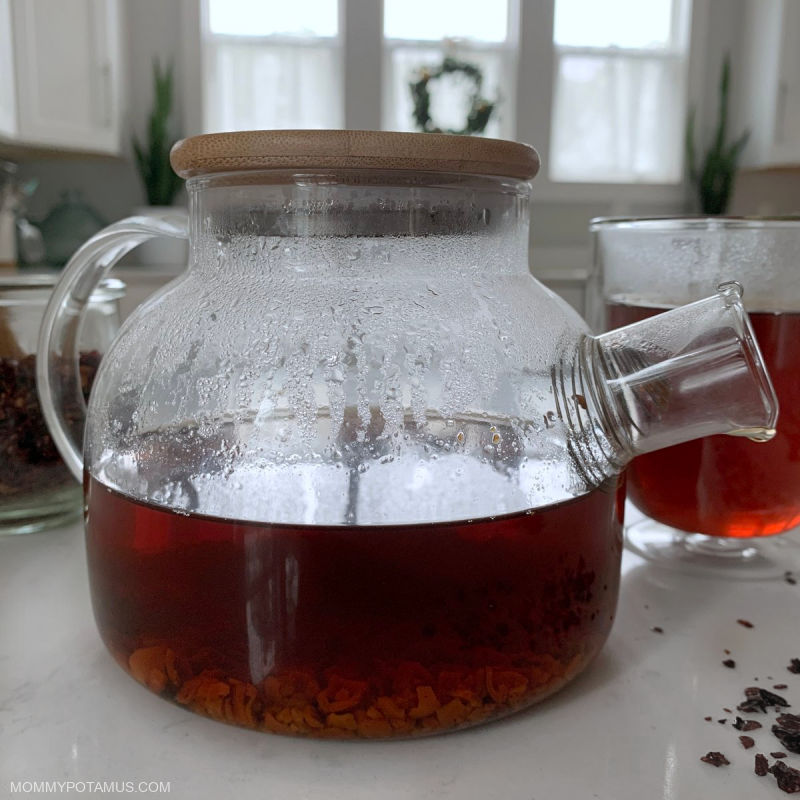
Rosehip Tea Recipe ^
When brewed in water, the beneficial compounds in rosehips are best extracted through a long simmering process known as a decoction. The tea is refreshing, slightly tart, lightly floral, and delightful to sip.
- 5 tsp deseeded dried rosehips
- 2 cups water
Add the water and rosehips to a small pot or teapot. Bring water to a boil, then reduce heat and simmer gently for 10 minutes. Strain out rosehips, sweeten if desired, and serve.
Note: As I mention in the safety section below, the seeds found in fresh rosehips and dried whole rosehips are covered in tiny hairs that irritate the mouth and throat. I recommend using deseeded dried rosehips in this recipe, but you can also use fresh or whole dried ones as long as you strain through a paper coffee filter before serving.
Do rosehips have any side effects? ^
According to the Botanical Safety Handbook, 2nd edition, it’s a Safety Class 1A herb – the safest rating possible. It is described as:
- Herbs that can be safely consumed when used appropriately.
- History of safe traditional use
- No case reports of significant adverse events with high probability of causality
- No significant adverse events in clinical trials
- No identified concerns for use during pregnancy or lactation
- No innately toxic constituents
- Toxicity associated with excessive use is not a basis for exclusion from this class
- Minor or self-limiting side effects are not bases for exclusion from this class
However, the handbook notes that small hairs found on the seeds of fresh and dried rosehips can irritate the mouth, throat and/or other areas.
These hairs are usually removed during processing, so they’re not something you need to worry about if you’re buying deseeded dried rosehips, rosehip powder, etc.
Whole dried rosehips will have some hairs on the inside of the fruit alongside the seeds, but they can be used in liquid herbal preparations as long as you strain them well.
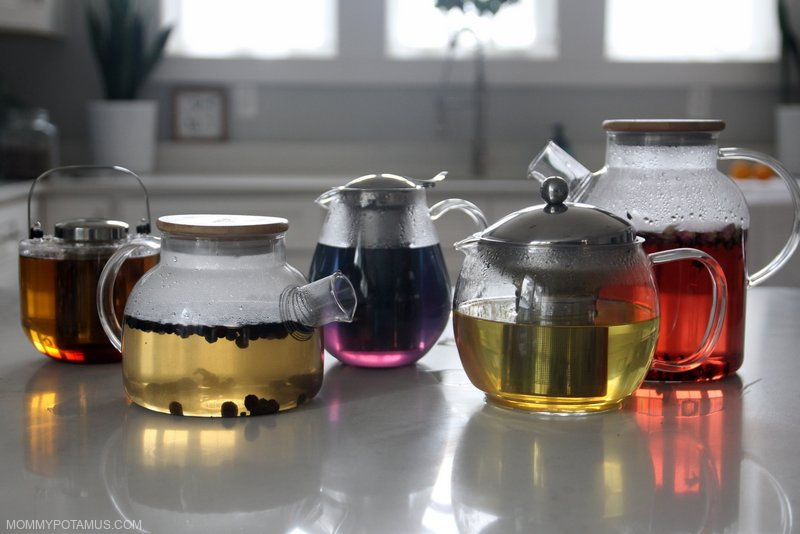
Recommended Teapots ^
Anytime I post about the benefits of a particular herbal tea I’m sipping on, I usually get a lot of comments like “Love that herb so much but seriously TELL ME ABOUT THAT TEAPOT.”
Here’s a list of my top five favorites, including a few that are stovetop safe.
Rosehips Tea Recipe ^
Ingredients
- 5 tsp deseeded dried rosehips
- 2 cups water
Instructions
- Add the water and rosehips to a small pot or teapot.
- Bring water to a boil, then reduce heat and simmer gently for 10 minutes.
- Strain out rosehips, sweeten if desired, and serve.
Notes
 Tried this recipe?
Mention @mommypotamus or tag #mommypotamus!
Tried this recipe?
Mention @mommypotamus or tag #mommypotamus!
Nutrition
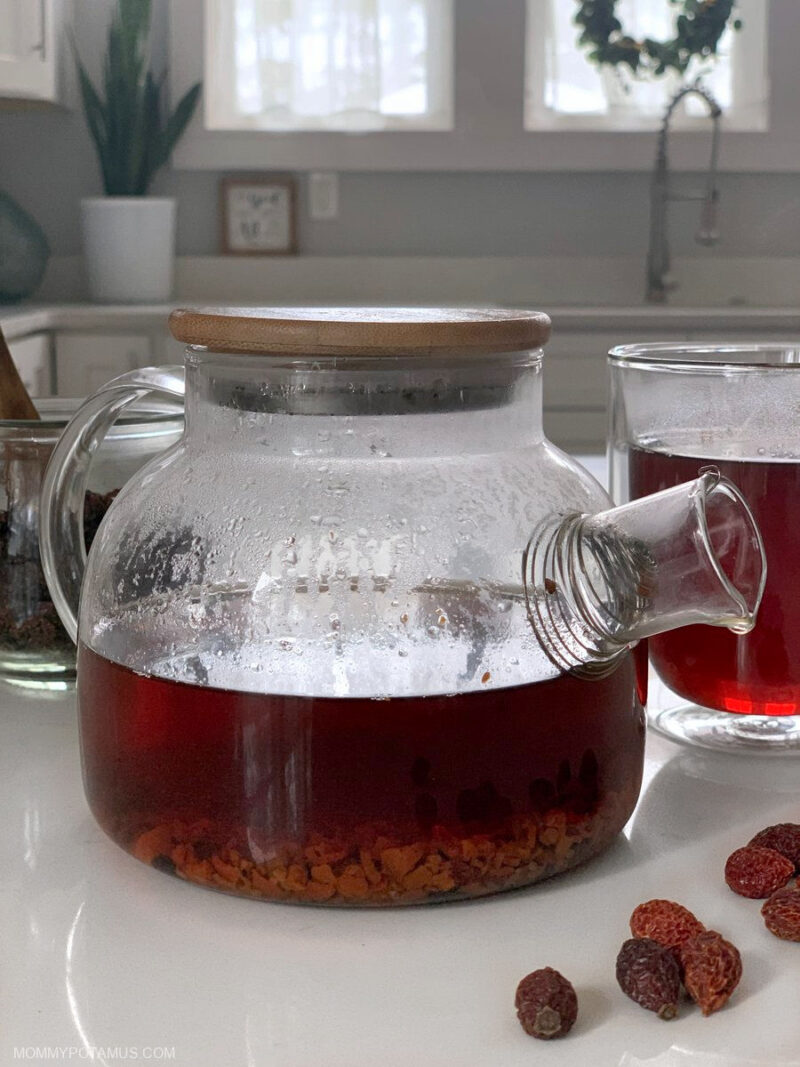
Want more research-backed natural remedies?
No problem, I’ve created a free ebook for you – Kitchen Apothecary: 25+ Natural Remedies Using Ingredients From Your Pantry – as a gift for signing up for my newsletter. You’ll also get updates when I post about safe essential oils for pregnant/breastfeeding mamas, exclusive gifts and coupons (I was able to give away a jar of free coconut oil to anyone who wanted it recently!), plus other goodies.
Sign up using the form below.
Sources
1. Scientific American (2001) Mother Nature’s Medicine Cabinet
2. Desborough, Michael and Keeling, David (2017) The Aspirin Story – From Will To Wonder Drug
3. John Bostock, M.D., F.R.S., H.T. Riley, Esq., B.A., Ed. Pliny the Elder, The Natural History
4. Mármol, Inés et. al. (2017) Therapeutic Applications of Rose Hips from Different Rosa Species
5. Tursun, Xirali et. al. (2016) Anti-Inflammatory Effect of Rosa rugosa Flower Extract in Lipopolysaccharide-Stimulated RAW264.7 Macrophages
6. Lee, Myung‐hee et. al. (2018) Skin anti‐inflammatory activity of rose petal extract (Rosa gallica) through reduction of MAPK signaling pathway
7. Ueno, Hiroshi et. al. (2019) Anti-stress effects of the hydroalcoholic extract of Rosa gallica officinalis in mice
8. Yance, Donald (2013) Adaptogens in Medical Herbalism
9. Brill, Steven and Dean, Evelyn (1994) Edible and Medicinal Plants: Identifying and Harvesting Edible and Medicinal Plants in Wild (and Not So Wild) Places
10. Choi, Franchesca et. al. (2019) Oral Collagen Supplementation: A Systematic Review of Dermatological Applications
11. Tominaga, Kumi (2017) Protective effects of astaxanthin on skin deterioration
12. Schagen, Silke K. et. al. (2012) Discovering the link between nutrition and skin aging
13. Grether-Beck, S. et. al. (2016) Molecular evidence that oral supplementation with lycopene or lutein protects human skin against ultraviolet radiation: results from a double-blinded, placebo-controlled, crossover study
14. Varani, J et. al. (2000) Vitamin A antagonizes decreased cell growth and elevated collagen-degrading matrix metalloproteinases and stimulates collagen accumulation in naturally aged human skin
15. Quezada, Maria (2010) Finding Infinity, Vol. 1: an Easy Aromatherapy Guide to Blending Essential Oils (The Anti-Aging Secrets)
16. Declair, V (1997) The usefulness of topical application of essential fatty acids (EFA) to prevent pressure ulcers
17. Ando, H (1998) Linoleic acid and alpha-linolenic acid lightens ultraviolet-induced hyperpigmentation of the skin
18. Andersson, U. et. al. (2012) Effects of rose hip intake on risk markers of type 2 diabetes and cardiovascular disease: a randomized, double-blind, cross-over investigation in obese persons
19. Cavalera, Michele et. al. (2017) Dietary rose hip exerts anti-atherosclerotic effects and increases nitric oxide-mediated dilation in ApoE-null mice
20. Bensky, Dan (2015) Chinese Herbal Medicine Materia Medica
21. Anitra C Carr and Silvia Maggini (2017) Vitamin C and Immune Function
22. Hussain, Tarique (2016) Oxidative Stress and Inflammation: What Polyphenols Can Do for Us?
23. Mármol, Inés et. al. (2017) Therapeutic Applications of Rose Hips from Different Rosa Species
24. Winther, K. et. al. (2015) Bioactive ingredients of rose hips (Rosa canina L) with special reference to antioxidative and anti-inflammatory properties: in vitro studies
25. Cohen, Marc (2012) Rosehip – an evidence based herbal medicine for inflammation and arthritis
26. New York Times (2015) Some of My Best Friends Are Germs
27. Singh, Amit Kumar et. al. (2019) Beneficial Effects of Dietary Polyphenols on Gut Microbiota and Strategies to Improve Delivery Efficiency
28. Hoffman, David (2016) The Complete Herbs Sourcebook
29. de la Foret, Rosalee (2017) Alchemy of Herbs




